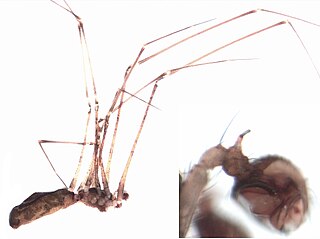| Paratupua | |
|---|---|
| Scientific classification | |
| Kingdom: | Animalia |
| Phylum: | Arthropoda |
| Subphylum: | Chelicerata |
| Class: | Arachnida |
| Order: | Araneae |
| Infraorder: | Araneomorphae |
| Family: | Physoglenidae |
| Genus: | Paratupua Platnick, 1990 [1] |
| Species: | P. grayi |
| Binomial name | |
| Paratupua grayi Platnick, 1990 | |
Paratupua is a monotypic genus of araneomorph spiders in the Physoglenidae family found in Victoria, Australia. [1] It contains the single species, Paratupua grayi. Though it's sometimes misspelled Paratupa, [2] the correct spelling is "Paratupua". [2] [1]

In biology, a monotypic taxon is a taxonomic group (taxon) that contains only one immediately subordinate taxon.
A genus is a taxonomic rank used in the biological classification of living and fossil organisms, as well as viruses, in biology. In the hierarchy of biological classification, genus comes above species and below family. In binomial nomenclature, the genus name forms the first part of the binomial species name for each species within the genus.

The Araneomorphae are an infraorder of spiders. They are distinguished by having chelicerae (fangs) that point diagonally forward and cross in a pinching action, in contrast to the Mygalomorphae, where they point straight down. Most of the spiders that people encounter in daily life belong to the Araneomorphae.
Both genus and species were first described by Norman I. Platnick in 1990, [2] who placed it with the Synotaxidae. In 2017, it was moved to the Physoglenidae. [3]

Norman I. Platnick is an American biological systematist and arachnologist. He is a Professor Emeritus of the Richard Gilder Graduate School and Peter J. Solomon Family Curator Emeritus of the invertebrate zoology department of the American Museum of Natural History. A 1973 Ph.D. recipient at Harvard University, Platnick has described over 1,800 species of spiders from around the world, making him the second most prolific arachnologist in history, behind only Eugène Simon. Until 2014 he was also the maintainer of the World Spider Catalog, a website formerly hosted by the AMNH which tracks the arachnology literature, and attempts to maintain a comprehensive list, sorted taxonomically, of every species of spider which has been formally described. In 2007 he received the International Society of Arachnology's Bonnet award, named for Pierre Bonnet, in recognition for his work on the catalog.
Physoglenidae is a family of araneomorph spiders first described by Alexander Petrunkevitch in 1928 as a subfamily of Pholcidae. It was later moved to Synotaxidae until a study in 2016 showed that they formed a distinct clade.


